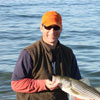Wildlife & Sport Fish Restoration Program
By Tom Keer
Nov 12, 2014
The Wildlife & Sport Fish Restoration Program (WSFR) is one of the industries best kept secrets. And it shouldn’t be, for every time boaters and anglers purchase gear, buy a fishing license or fuel up their boats they are supporting the program.
The Wildlife & Sport Fish Restoration Program (WSFR) is one of the industries best kept secrets. And it shouldn’t be, for every time boaters and anglers purchase gear, buy a fishing license or fuel up their boats they are supporting the program.
The program was created by the U.S. Fish & Wildlife Service (USFWS) half a century ago with a simple mission: to conserve and manage fish and game quantities. Along the way they created programs that immediately benefit anglers and boaters (such as fish stocking or repairing a boat ramp), and long term projects (like research or increasing the number of anglers). That present/future approach is a good one.
Some Fast Facts:
-Between 1952 and 2014, WSFR proved $7.9 billion in Wildlife & Sport Fish Restoration grants to state fish and wildlife agencies
-Last year, WSFR funded 337 Boating Access projects for a total of $60.5 million.
-Last year, WSFR funded 130 Aquatic Education projects (education, stewardship, and conservation) for a total of $17.6 million.
The USFWS also works to increase the number of national partnerships. Many hands make light work, so increasing the number of stakeholders is critical. Any group that uses water is a candidate, so travel/tourism boards that promote swimming, boating, sailing, canoeing, or camping are networking opportunities. Groups that rely on water quality such as aqua culture for raising fish or shell fishermen are similarly contacted. The more help we get the more we can improve our environment.
WSFR does more than pay for projects; they’re very involved in them as well. In inland areas, habitat improvements are done on freshwater ponds, lakes, and rivers whereas states with a saltwater coastline may have fisheries conservation work done on beaches, estuaries, saltponds, or flats. Improving boat ramps is a big focus as is fisheries management. Sometimes fish genetics are studied and artificial reefs are created. Regular surveys are also part of the mix and are particularly useful on the state level. Depending on the survey, questions can range from user profiles to understand who is fishing and boating to what areas or species of fish anglers believe need some help.
Maybe the Wildlife & Sport Fish Restoration program is like the unsung hero, a football lineman. But it’s a great program that certainly helps put the ball in the endzone.
Tom Keer is an award-winning freelance writer who lives on Cape Cod, Massachusetts. Visit him at www.tomkeer.com or at www.thekeergroup.com.
The program was created by the U.S. Fish & Wildlife Service (USFWS) half a century ago with a simple mission: to conserve and manage fish and game quantities. Along the way they created programs that immediately benefit anglers and boaters (such as fish stocking or repairing a boat ramp), and long term projects (like research or increasing the number of anglers). That present/future approach is a good one.
Some Fast Facts:
-Between 1952 and 2014, WSFR proved $7.9 billion in Wildlife & Sport Fish Restoration grants to state fish and wildlife agencies
-Last year, WSFR funded 337 Boating Access projects for a total of $60.5 million.
-Last year, WSFR funded 130 Aquatic Education projects (education, stewardship, and conservation) for a total of $17.6 million.
The USFWS also works to increase the number of national partnerships. Many hands make light work, so increasing the number of stakeholders is critical. Any group that uses water is a candidate, so travel/tourism boards that promote swimming, boating, sailing, canoeing, or camping are networking opportunities. Groups that rely on water quality such as aqua culture for raising fish or shell fishermen are similarly contacted. The more help we get the more we can improve our environment.
WSFR does more than pay for projects; they’re very involved in them as well. In inland areas, habitat improvements are done on freshwater ponds, lakes, and rivers whereas states with a saltwater coastline may have fisheries conservation work done on beaches, estuaries, saltponds, or flats. Improving boat ramps is a big focus as is fisheries management. Sometimes fish genetics are studied and artificial reefs are created. Regular surveys are also part of the mix and are particularly useful on the state level. Depending on the survey, questions can range from user profiles to understand who is fishing and boating to what areas or species of fish anglers believe need some help.
Maybe the Wildlife & Sport Fish Restoration program is like the unsung hero, a football lineman. But it’s a great program that certainly helps put the ball in the endzone.
Tom Keer is an award-winning freelance writer who lives on Cape Cod, Massachusetts. Visit him at www.tomkeer.com or at www.thekeergroup.com.
Popular Posts









